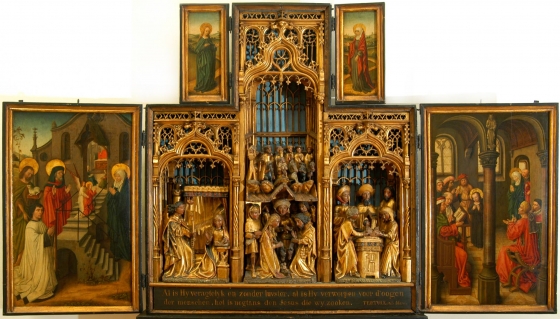This archived website 'Flemish primitives' is temporarily not being updated. Certain functionality (e.g. specific searches in the collection) may no longer be available. News updates about the Flemish primitives will appear on vlaamsekunstcollectie.be. Questions about this website? Please contact us at info@vlaamsekunstcollectie.be.
OCMW Brussels Loan in Sint-Janshospitaal

Who knows that the Public Centre for Social Welfare (OCMW) also has an art collection in its possession? And, who knows these collections? Beginning December 6 through June 7 2015, the OCMW of Brussels is loaning a painting to the Sint-Janshospitaal in Bruges (Musea Brugge), which is itself developed out of a historical OCMW collection.
The art collections of the OCMW are generally much older than the well-known museum collections. They are historically developed in care-providing institutions in Flanders and Brussels. The works of art were not collected for their artistic worth, but rather because they constitute a part of the daily activity in a care-providing institution. With the professionalisation of public care and the transition from Christian-inspired charitable institutions to that of a government financed, legally regulated organisation of social assistance for the needy (since 1976, the OCMW), there was a need to search for another objective for this patrimony of art.
Collections were dispersed, locked up in depositories and then forgotten, or even sold. In the best case, they received a museum destination in situ. An example of this is seen in the collections of the Sint-Janshospitaal and Onze-Lieve-Vrouw-ter-Potterie in Bruges. The collections are exhibited in their original context: a hospital for the needy. The Hospital Museum-the umbrella nomenclature for both locations-is the only museum that OCMW collections manages and is known on a national level.
In 2009, the museum established a work group that had as its mission to make the OCMW heritage better known to the public and at the same time to protect it. Administrators of the OCMW collections presented their art patrimony in a special edition of Openbaar Kunstbezit in Vlaanderen, and at the end of this year a collective website is expected. The Sint-Janshospitaal, moreover, annually invites a manager from the OCMW heritage to showcase its collection with a work of art of choice. This year, this is from the Museum of the OCMW of Brussels with a Brussels The Nativity from 1470-1530.
The altarpiece is not impressive for its size or extravagant gilding, but is endearing for its simplicity and naiveté. It was probably already present in the chapel of the Sint-Janshospitaal in Brussels in 1829. How the work of art came to be there is unknown. From this time dates the predella, and the polychrome, with facial expressions that are rendered with little refinement. The inelegant interventions were probably an adjustment to the new environment.
The work is in an outstanding condition. The work consists of a sculptured frame and four painted panels. It depicts scenes from the life of Mary and the childhood of Jesus. The traditional themes permeate the entire work of art.
The sculptured middle piece, in typical Brussels style and in the form of an inverted T, is divided into three tableaux: the Annunciation, the Nativity with a procession of the Magi above, and the Circumcision. They are distinguished from each other by architectural elements in a flamboyant Gothic style. On the backside of the figures of the circumcision, two hammers are implemented with a seal. The hammer is the Brussels seal of quality for the wood. The Brussels approval of the polychrome with the inscription ‘BRUESEL', and of the carpenter, is lacking.
In the center niche, we encounter the most important original elements. Below, we recognise a miniscule Baby Jesus and a man with a hammer. The head above a tower with ramparts behind likely symbolise the nearby lying city. Four panels encircle the middle portion. Mary and Saint Anne are standing above. On the left, Jesus is depicted amongst the Scribes, and to the right is the Task of Mary in the Temple. The patron of the work of art sits kneeling by the staircase. The grisailles on the external panels above portray the Synagogue and the Triumphant Church, and below are Mary and John the Baptist on Mount Calvary.
The faithful generally only saw the grisailles because the painting was only opened on important liturgical holidays. The vision of the polychromatic interior played heavily on the imagination. The work survived the Iconoclasm of 1566. With its original panels and sculptured groups, it is a wonderful example of liturgical and likewise artistic furniture.
Text: Mieke Parez (deputy curator Sint-Janshospitaal Bruges) and Aurélie Noirhomme (deputy curator OCMW Brussels)
(News item December 5 2014)







